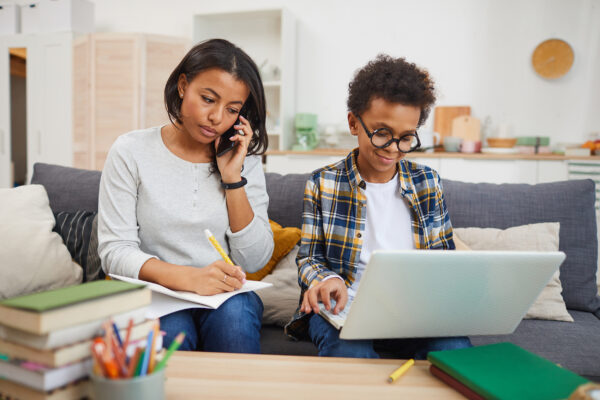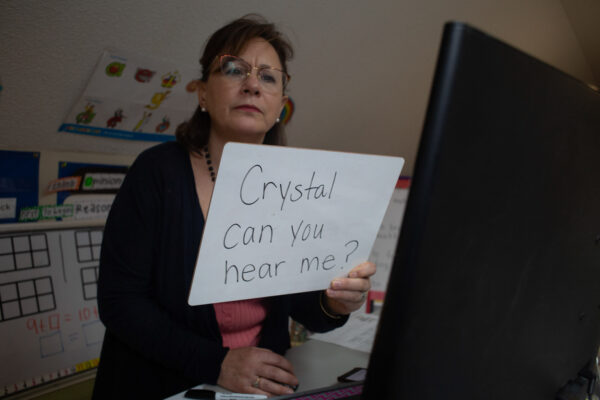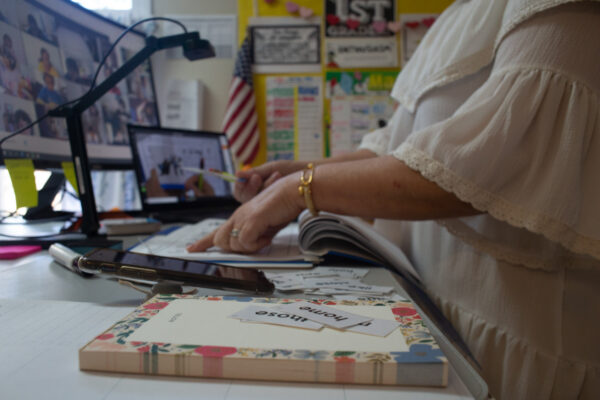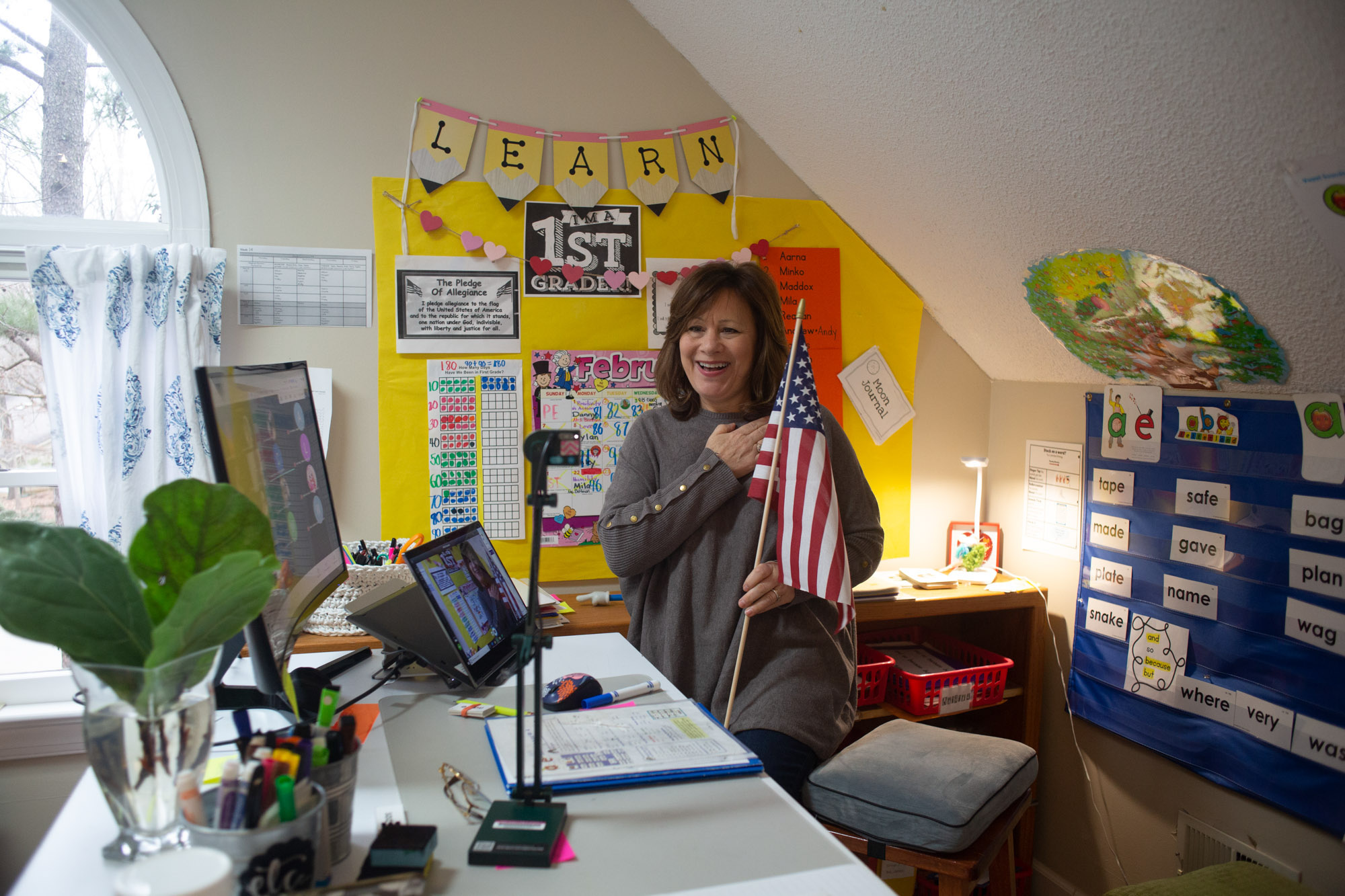The sound of a basketball bouncing down the hallway echoes across the speakers of the five computers tuned into Layla Dowdy’s Tuesday afternoon Zoom meeting. She excuses herself, hits the mute button, and exits her office. A few minutes later, she returns and apologizes. Her son decided to bring his basketball game indoors.
This is Dowdy’s “new normal” — a phrase that most of us have more than tired of since the pandemic began over a year ago. For Dowdy, normal means her kids whizzing by in the hallway during meetings. It means putting work aside to keep them engaged with online schooling. It means surprise pop-ins to show her the water they dyed with food coloring or a recent drawing or their new basketball skills. It means Dowdy can’t ever fully focus on either situation. She has to pay attention to her meeting while listening for the sounds of her kids and vice versa.
The pandemic has stretched all parents far beyond their bandwidth. Dowdy feels that pull every day. She’s no longer just “mom.” She’s a teacher, a friend, a counselor, and a coach. She’s trying to fill all the shoes of the people her kids can’t see. And she’s trying to keep up with her own to-do list and the countless meetings she needs to participate in as director of the UNC Office of Research Communications.
“It’s not hard — it’s impossible,” Dowdy says. “And then if you take away even one resource, like internet or food stability, it would be unimaginable.”
COVID-19 has disrupted the work-home life balance of millions of people worldwide, adding stress to parents, teachers, and children alike as they attempt to adapt and make the best of the cards they’ve been dealt. Fear of infection, increased mental health issues, and reduced socialization are stressors everyone is coping with, but when students also don’t have access to stable Wi-Fi, computers, or secure food and housing, the challenges only multiply.
With Governor Cooper’s announcement that all North Carolina Public Schools will reopen for in-person learning by the end of March, findings from UNC researchers in epidemiology and education are more relevant than ever to provide the support that parents, teachers, and students will need in the transition from hybrid to in-person learning.
It takes a village
“What I think is really interesting about public schools is they bring us together,” says Thurston Domina, a professor in the UNC School of Education. “I was scared when the pandemic hit and schools went remote-only. What was going to replace that sense of community?”
Domina, who studies the interactions between families and schools, found that virtual schooling encouraged a kind of bringing together of its own. By focusing on how parents were communicating with one another, Domina learned that parent-to-parent interactions can help make schools more equitable, even remotely.
Oftentimes, parenting is thought of as an individualistic, parent-to-child experience, he explains. His team wants people to think of parenting as a collective activity.

Parenting isn’t something you take on alone, according to School of Education researcher Thurston Domina. It’s a collective activity involving other parents, teachers, and family members. (photo by Adobe Stock)
“You don’t parent alone,” he says. “You parent in connection with other parents. You arrange playdates and exchange information. The nature of those connections that you have changes the way you raise your kids, the resources you have, and the resources your kid has.”
In a survey sent out to a racially and ethnically diverse mid-sized city district, Domina’s team asked elementary school parents about the ways they communicate with each other, what they talk about with other parents, the access they have to computers and Wi-Fi, how schools are communicating with parents, and their children’s engagement with remote learning.
While they were not surprised to find socioeconomic inequalities in students’ remote experiences, they were awed by how strongly parent-to-parent connections rose above and beyond other considerations. The survey showed that parent-to-parent connections helped kids — from affluent and less affluent families alike — engage in remote school transitions. Such connections were particularly important for kids from less affluent families, whose financial issues resulted in less access to resources.
“When you feel like you’re in it with other people, you can commiserate and share tips and muddle through it,” says Domina, who adds that going through this alone would likely elicit an entirely different emotional response.
The team hopes that this study can help districts identify what forms of communication work and what doesn’t — something that will be especially important for softening the transition back to in-person classes.
Most parents reported feeling happiest when teachers offered a wide range of communication methods with parents and students alike. But extra office hours, multiple modes of instruction, and constantly fighting against elementary school attention spans places a lot more strain on teachers, Domina points out.
The eyes and ears on the ground
With funding from the North Carolina Policy Collaboratory, UNC epidemiologist Kimberly Powers and her team conducted a two-part study to gain insight into how N.C. public school districts have handled reopening and the experiences and perspectives of teachers.
By the end of December 2020, about three-quarters of North Carolina school districts had returned to in-person learning in some capacity. In a study that began this past fall, Powers and her team completed a document review of school districts’ reopening methods, infection mitigation approaches, and equity considerations alongside an extensive survey to shed light on the experience of North Carolina teachers.
The document review considered all 115 public school districts in the state and found inconsistencies for how schools reopened across the state. At the start of the school year, only 43 percent of districts offered face-to-face instruction — a percentage that increased over time and with a lot of variation in timing and protocols.
“You’ve got apples and bananas and oranges and grapes and pineapples that we’re trying to compare with these schools,” Powers says. “It’s frustrating to see the issue of school reopening being painted in a really black-and-white way. As an epidemiologist who has learned over the years that the devil is in the details and everything depends on everything else, there’s a lot of variability.”
Yes-or-no questions broadly asking whether in-person schools are safe miss a lot of important nuances, Powers stresses.
Given that it sometimes took the team hours to scour through documents or even find them in the first place, the researchers recommend that districts make improvements to the transparency and accessibility of their reopening plans. The team also noted equity concerns. While most districts included plans to address food insecurity and nutritional support, considerations around home insecurity and resources for English as a second language students were not as apparent.
The second part of the study surveyed 700 K-12 teachers in four districts across North Carolina: one in the mountains, two in the Piedmont, and one along the coast. They asked teachers about the training they received before returning to the classroom, how stressed they were compared to prior years, what mitigation measures their schools implemented, and the level of adherence to those measures they saw on the ground.
[row]
[column lg=”6″ md=”12″ sm=”12″ xs=”12″ ]

Suzanne Zaccardo, an educator of 25 years, teaches her first grade class virtually from her attic in Cary, North Carolina, which she has converted into a classroom. (photo by Eva Hagan)
[/column]
[column lg=”6″ md=”12″ sm=”12″ xs=”12″ ]

Learning from home isn’t for everyone, and Zaccardo struggles at times to give all her students the full school experience they need. If her students need extra help, she makes the time to meet with them virtually, even after a long, eight-hour school day. (photo by Eva Hagan)
[/column]
[/row]
“We certainly expected that they would report high levels of stress and fatigue, but just the sheer numbers really sort of knocked me off my chair and drove the point home as to just how much stress teachers are under,” Powers says.
Ninety-two percent of teachers reported being more tired and stressed than in prior years, and three-quarters perceived their teaching to be less effective on student learning than before. In addition, about a quarter of teachers reported not receiving any training at all prior to their return to in-class instruction and less than half felt “very knowledgeable” about their role in mitigation strategies.
Teacher input also helped the team determine that some public health measures, like wearing a face mask on school grounds, were enforced inconsistently. Other areas of potential improvement included recommendations around communication between schools and parents about the proper use of face coverings and public health campaigns to deliver sound information to teachers about vaccines.
“Vaccines for school staff have always been sort of a beacon that I’ve been hoping for, and I think that they will be a huge help going forward,” Powers says. “When teachers are protected by vaccines, the risk-benefit ratio changes, and a lot of these questions surrounding schools reopening become less fraught.”
With grace and empathy
Of course, students at all levels are feeling the strain of this pandemic. Dana Griffin, an associate professor in the School of Education, has seen firsthand the stress that students are feeling right now.
Students from primary school to higher education are feeling the strain of remote and hybrid learning, trapped for hours in front of their computer screen and robbed of any real social interaction with peers — not to mention the additional struggles felt by students with limited access to resources. The inequities within the education system have driven much of Griffin’s research, and the pandemic has only exacerbated them.
Griffin’s advice for educating during a pandemic? Awareness, grace, and empathy. Not every student has access to the same resources and learning conditions, something she says educators at all levels need to be aware of as public schools and universities begin their return to in-person instruction. Assessing where there are gaps in an individual student’s learning and then providing them with the resources they need to continue learning will be crucial moving forward.
“There are systemic biases and stereotypes in schools that continue to oppress certain populations and cause schools to struggle to meet the needs of students of color and low-income populations,” Griffin says. “These kids are going to have needs, just as all kids are going to have needs, but what we tend to do is penalize certain groups over others. That we can’t do.”

A UNC student studies in Davis Library amidst signage reminding visitors to wear a mask and maintain social distancing. (photo by Elise Mahon)
Students who “fall behind” academically and are identified as having have more behavioral issues often come from low-income, underrepresented communities. Considering the mental health issues and trauma students are potentially dealing with, a return to schools may result in students acting out behaviorally as a means of coping.
“We need to change our mindsets on how we view students, how we view behavior, and how we view academic growth when we come out of this pandemic — and even now,” she says.
Griffin believes schools need to reconsider how they deal with students who act out, providing mental health resources and support rather than punishments like suspension.
As a professor last semester, Griffin also has key insight into the struggles of college students right now. College is a time when not just academics but socializing and developing independence are integral. For many students living at home or isolated to their dorms and apartments, there’s a feeling of loss on top of other fears and stressors that come with the pandemic. These feelings are likely causing more conflict between parents and students and are seriously impacting student mental health.
In fact, a recent study led by UNC economist Jane Fruehwirth found that first-year college students are reporting symptoms of depression and anxiety significantly more than they were before the pandemic. More specifically, moderate to severe anxiety within this demographic increased by 40 percent and moderate to severe depression by 48 percent. Black students, in particular, experienced an 89 percent increase in depression symptoms.
Griffin quickly realized that showing increased empathy for her students would be crucial. She began her lectures with student check-ins, made assignments more flexible, and adjusted her availability outside of classes to better fit student needs.
“One of the things that I want for my students if they can’t thrive right now is to survive,” she says. “So how can we help them focus on just surviving and getting through and building resiliency?”
Griffin also believes that showing others and yourself some grace in these unprecedented times is necessary. The resiliency and accomplishments of students, teachers, and parents — despite all these stressors — impress and inspire Dowdy, Domina, Powers, and Griffin alike.
“I think we’re starting to see more resilience across our society than a lot of people might have expected,” Domina says. “Families didn’t have a choice, and they found a way to make it happen. We have to give ourselves credit.”


